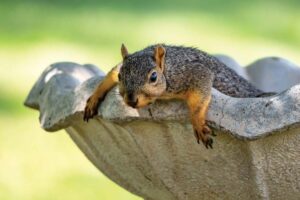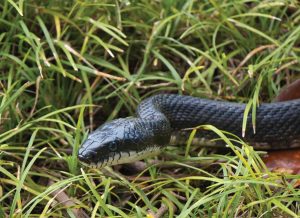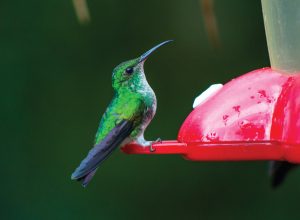Every winter for the past 25 years, I’ve bundled up and trudged out to the bird feeding station to make sure my feathered friends have an adequate supply of nutritious food. During the bitter cold months, birds can burn 75 percent of their fat reserves overnight to keep warm. Having a readily available protein source to recoup their fat is vital for survival.
Throughout the years, I have always fed suet cakes and black sunflower seeds. As a result, I’ve been entertained by countless birds in an amazing variety. They come to the feeders by the hundreds. Sometimes there will be so many they will eat almost 2 gallons of black sunflower seeds and one or two suet cakes each day.
Feeding black sunflower seed and suet minimizes the presence of less desirable guests like the invasive English sparrow and European starlings.
My sunflower seed feeder is positioned over an old concrete slab, bringing a proliferation of ground-feeding birds. The sunflower seeds bring a variety of species, commonly including northern cardinal, dark-eyed junco, house sparrow, house finch, mourning dove, American goldfinch, black-capped chickadee, jays, common sparrows, grosbeaks, titmouse, finches, buntings and white-breasted nuthatch.
With suet cakes available, there is a combined attraction for woodpeckers including the massive pileated woodpecker, red-bellied woodpecker, downy woodpecker as well as chickadees, creepers, blue jays, wrens, starlings, warblers, towhees, finches, cardinals, nuthatches, white-throated sparrows, American robins and kinglets.
One of our treasured visitors to the suet blocks is the pileated woodpecker. The crow-size, gaudy, black-cloaked birds with bright white and red heads are breathtaking. Looking like the amazing cartoon Woody Woodpecker, we refer to the couple and their young ones as “The Woodrows.”
The pileated woodpeckers have a raucous call sounding much like what one would expect to hear in the jungle. The Woodrows have learned if they call enough, I’ll come out and refill the empty suet dispensers. You might say I’m at their beck and call.
Sometimes I have looked out to see the feeding station abandoned with no birds in sight. When it happens, I scan the surrounding trees looking for a cooper’s hawk. The cooper’s hawk has a tendency to hunt around bird feeders looking for easy pickings among the crowd. I don’t like a hawk making a meal of one of the birds I am feeding, but it is nature, and hawks must eat, too.
The birds at my feeding station have become used to me over time. The least skittish are the downy woodpeckers and the chickadees. It is not unusual to see many birds patiently perched in the branches of the surrounding trees waiting for me to fill the feeder. When I shoveled the first scoop of sunflower seeds into the feeder, a young downy woodpecker flew and landed on the feeder within 6 inches of my nose. I let out an expletive and said, “Wait your turn!”
In late February and early March, we are blessed with many cardinals gathering at the feeder. For a few weeks this time of year, the males do not fight over territory and females. They peacefully hang out with one another.
Three years ago, my wife and I divided up the backyard and began to count and tally the birds. Our last approximate number was 26 male cardinals and what appeared to be an equal number
of females. Perched among the boughs of the evergreens and framed by glowing white snow, it was an awesome sight.
Let’s not forget our feathered friends during the lean months of winter.










